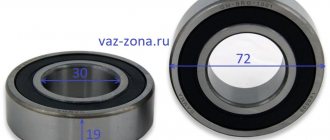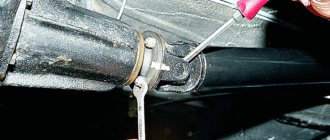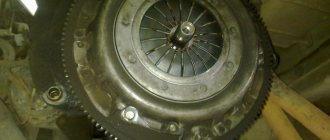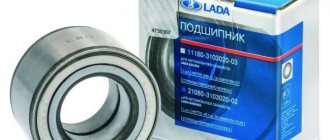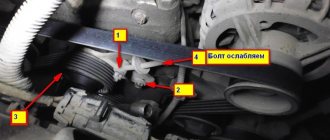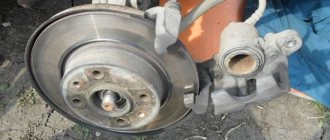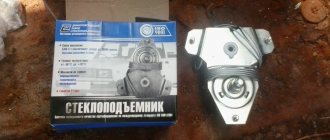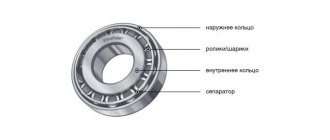Priora support bearings are installed on the struts and are usually changed along with them. But it also happens that bearings fail much earlier - the quality of not all products is ideal. This element ensures the correct functioning of the entire suspension, as well as the rotation of the wheels. If the bearings fail, there are many inconveniences that affect the ride. Even a person who knows only superficially the design of the car can make the replacement independently.
Bearing manufacturers
You need to select spare parts before replacing the bearings on the machine. Similar products are installed on Priora and Tens. The highest quality products are produced by the following companies:
- SKF.
- KOYO.
- SNR.
The cost of products is very high - this is a fact. But their service life is longer than that of their domestic counterparts. If you want to save money, purchase domestically produced products, their cost is about 500-700 rubles per piece. It is advisable to choose spare parts from those companies that are recommended by AvtoVAZ. Remember that installing a new bearing will ensure stable operation of the suspension and will eliminate rattling in the place where the strut is attached to the body for a long time.
Symptoms of malfunction and checking the front strut support bearing
When malfunctions occur in the front suspension of a car, one of the first measures that its owner should take is to check the support bearing located between the support and the upper spring cup. To do this, you will need to grab the “cup” of the rack with your hand (put your hand on the support) and rock the car. Constant, sharply changing loads, including shock loads in combination with abrasive dust particles, contribute to the wear of the components of the support strut bearing and ultimately completely disable it. As a result, it begins to play, knock, squeak or squeak, and the shock absorber rod deviates from its axis.
Diagram of the support bearing operation
Such problems with its operation can lead to more serious consequences in the car’s suspension. Since wear of the support bearing will lead to a violation of the wheel alignment angles, and consequently, a deterioration in the car’s handling and accelerated tire wear. How to check and which manufacturer of thrust bearings to give preference to when replacing - we will tell you about all this in more detail.
Let's consider these questions:
Signs of a faulty support bearing
The main sign of a breakdown, which should alert the driver, is a knocking sound in the area of the front left or right side members . In fact, other suspension parts can also be sources of knocking and squeaking, but you need to start checking with the “support”.
Unpleasant sounds are especially noticeable when driving on uneven roads, over potholes, on sharp turns, and when the car is heavily loaded. That is, in conditions of critical suspension operation. In addition, the driver will probably subjectively feel a decrease in the car’s controllability. The steering does not respond so quickly to its actions; a certain inertia appears. The car also begins to “scour” along the road.
Many manufacturers provide a service life of support bearings of 100 thousand km, but due to difficult operating conditions (in particular, poor road conditions), they will require replacement after 50 thousand mileage, and if the quality of the unit fails, then often after 10,000 km .
The main reasons for the failure of support bearings are dust and water penetrating inside, lack of lubrication there, and also, not rarely, due to a strong impact on the rack. Read more about these and other causes of support bearing failure:
- Natural wear of the part . Unfortunately, the quality of domestic roads leaves much to be desired. Therefore, when operating the machine, be prepared for the fact that the bearings will be subject to more wear than their manufacturer claims.
- Sand and dirt getting inside the mechanism . The fact is that a journal bearing is a type of rolling bearing, and it does not structurally provide protection from the mentioned harmful factors.
- Abrupt driving style and failure to comply with speed limits. Driving on bad roads at high speed leads to excessive wear not only on the support bearing, but also on other elements of the vehicle’s suspension.
- Low quality parts or defects . This is especially true for domestically produced bearings, in particular for VAZ cars.
Front support device
How to check a support bearing
Next, we will consider the question of how to determine a faulty support bearing with your own hands based on a characteristic sign. This is quite easy to do. To recognize how support bearings knock, there are three methods for checking the support bearing at home:
- It is necessary to remove the protective caps and press the upper element of the front strut rod with your fingers. After this, rock the car from side to side by the wing (first in the longitudinal and then in the transverse direction). If the bearing is faulty, you will hear a familiar knocking noise that you heard when driving a car on a rough road. In this case, the car body will sway, and the stand will either stand still or move with a smaller amplitude.
- Place your hand on the front shock spring coil and have someone sit behind the wheel and turn the steering wheel from side to side. If the bearing is worn out, you will hear a metallic knock and feel the recoil with your hand.
- You can focus on sound. Drive your car on uneven roads, including speed bumps. When there is a significant load on the suspension system (sharp turns, including at high speed, driving over bumps and holes, sudden braking), a metallic knocking sound of the support bearings will be heard from the front wheel arches. You will also feel that the car's handling has deteriorated.
Regardless of the condition of the support bearings, it is recommended to check their condition every 15...20 thousand kilometers.
Checking the “supporters” on VAZs
How do support bearings knock?
To extend the service life of a given bearing, very often, if the design allows it, mechanics wash and change the lubricant. If the part is partially or completely out of order, the support bearing is not repaired, but replaced. In this regard, a logical question arises - which support bearings are best to purchase and install?
How to choose support bearings
Support bearing
So, today on the auto parts market you can find “supports” from different manufacturers. It is best, of course, to buy original spare parts that are recommended by the manufacturer of your car. However, most car owners, as an alternative, buy non-original bearings in order to save money. And here a kind of lottery arises.
Some manufacturers (mainly from China) produce quite decent products that can, if not compete with original spare parts, then at least come close to them. But there is a danger of buying an open marriage. Moreover, the likelihood of purchasing a low-quality bearing is much higher. We present to you information about popular brands of journal bearings, reviews of which we were able to find on the Internet - SNR, SKF, FAG, INA, Koyo.
When purchasing branded products, always pay attention to the presence of branded packaging . It is, in fact, an analogue of a passport for a bearing, which is usually issued by domestic manufacturers.
SNR - thrust and other bearings are produced under this brand in France (some production facilities are located in China). The products are of high quality and are used by various car manufacturers in Europe (such as Mercedes, Audi, Volkswagen, Opel, etc.) as originals.
| Positive reviews | Negative reviews |
| SNR bearings are made of very high quality; if you take proper care of them, they will give you twice the service life specified by the manufacturer. These bearings have very good carburization of the working surface; if you do not overheat it and take care of the lubrication, it becomes indestructible. | Unfortunately, after only six months it broke down for me - it began to buzz noticeably. Before this, the car ran for 8 years on factory bearings, until the right one flew off after falling into a hole. I used the new bearing from May to October on a wheel with a cast balanced disk, then I changed to a new, also balanced, stamped one with winter tires, and then in February the buzzing started. I didn’t get into any potholes, I didn’t exceed the speed, the disc and tires were in order, and this SNR was ordered to be urgently changed during maintenance. |
| I have installed SNR bearings many times and never encountered any problems. They fit into place without problems, mileage is excellent. The safety margin is clearly decent, since even if a bearing fails, it still leaves quite a lot of time to find a new one and replace it. It's noisy, but it drives. | Like many car enthusiasts, I often have to deal with the problem of spare parts. Of course, I would like to buy something that is not expensive and of high quality, but as often happens, these two factors are not comparable. I can't say the same about the SNR bearing. The bearing is relatively inexpensive and, if used correctly, can even last its entire life, but it’s better, of course, not to take risks - drive it as long as it’s supposed to, take it off and install a new one. |
What is required for replacement
In order to independently replace the support bearing of the Priora strut, you need to have a minimum set of tools on hand. You will have to completely dismantle the shock absorber strut, and this is not an easy task. But try to outline the position of all elements relative to each other - this will allow you to avoid adjusting the camber angles in the future. You need the following tool:
- Set of wrenches and socket heads.
- Screwdriver.
- Marker.
- Puller for tie rod ends.
- Puller for springs.
Having all these tools, you can start repairing. It is also advisable to have strong steel wire on hand. If you follow all the recommendations, you will complete the repair in an hour, or two at most. This is relatively little.
The price of a support bearing for a Priora is no more than 700 rubles (if you purchase domestic products). Repair at a service station will cost the same as spare parts, sometimes more. There are no difficulties in the work, then there is simply no point in overpaying.
When to change
Another equally popular question. In general, bearings have to be replaced as they break and wear out.
If we imagine ideal operating conditions, then factory support elements can last 100 thousand kilometers. This is their declared resource.
In real conditions, taking into account the condition of the roads and the frequent entry of dirt into the bearing, a scheduled replacement should be performed every 50 thousand kilometers or every 2-3 years. This is especially true for situations where bearings have already been replaced before and now you have non-factory products.
Examination
Before proceeding directly to replacing the suspension element, you should make sure that it is really worn out, broken and needs urgent replacement.
We recommend carrying out these measures not only when signs of wear are detected, but also as preventive measures. This way you can find faults in time and take appropriate action to eliminate them.
The check should be carried out approximately after every 15-20 thousand kilometers. The procedure is carried out as follows:
- Turn off the car, turn on the handbrake and install chocks under the wheels. Safety comes first;
- Lift the hood, remove the cover located on the hub bearing from the glass;
- Touch the support with your palm, and in the meantime your partner should rock the car. Moreover, it should be swung to the sides;
- Make sure that the stand does not “play”;
- If during rocking you hear extraneous sounds, crunches or squeaks with knocks, then all is clearly not well with the bearing. The only correct solution is to replace the element.
What does a breakdown lead to?
When signs of a support bearing failure begin to appear, many car owners simply ignore it. But in vain. In fact, this can lead to very sad consequences for your car and budget.
Worn element
It’s not uncommon for a worn-out prop to break after hitting a pothole, of which there are more than enough on our roads. This led to the formation of a hole on the hood, since the support simply pierced the metal. If at the same time you were moving at low speed, then you are lucky; you will only have to repair the body. And I don’t even want to talk about the support column breaking down at speed. Let's just say that there were deaths.
Broken hood
All this is said not with the intention of scaring, but to make you think about the importance of timely repair of the support.
Preparation for repair
Before you begin any repairs, you need to do some preparation. To do this, perform a few simple manipulations:
- Park the car (Priora or Ten, it doesn’t matter at all, the operating algorithm is the same for them) on a level surface.
- Fix the position of the car - place shoes under the rear wheels, squeeze the handbrake and engage first or reverse gear.
- Remove all the front wheel bolts from the threads (it is advisable to replace the bearings on both struts).
- Lift up the side on which you plan to replace the support bearing first.
- Remove the entire wheel.
At this point, the preparation stage can be considered complete; it is time to disassemble the suspension and replace worn elements. Pay attention to the condition of all boots - if they are damaged, be sure to replace them.
How much will it cost to replace a support bearing on a Priora?
The cost of the “support” for the LADA Priora model starts from 300 Russian. rub. This is exactly how much you will have to pay for an original spare part with catalog number 2170-2902821. However, you can also purchase more advanced spare parts from others, you can pay attention to “TRACK”, “SS-20” and also “FENOX” have proven themselves well. Their cost is more expensive, about 800 Russian. rub. for 1 piece
If you need to replace the entire upper support, you will have to pay an amount of 1200-3000 Russian. rub.
Removing the rack
Perform further work according to the following scheme:
- Remove the cotter pin from the hole in the steering pin and unscrew the nut.
- Install the puller and remove the tip pin, move it to the side.
- Move the brake hose to the side.
- Use a marker to mark the position of the steering knuckle relative to the shock absorber strut - this is what affects the camber angle of the wheels.
- Unscrew the nuts from the bolts securing the strut to the knuckle and remove them.
- Move the hub and steering knuckle down slightly.
- In the engine compartment, use a 13mm wrench to unscrew the three nuts from the studs securing the Priora support bearing to the body.
After all these steps, you can remove the entire rack assembly; nothing is holding it in place. In this case, the spring will not unclamp - it still “sits” firmly on the rack.
What is this?
It is not uncommon for owners of the domestic “fourteenth” VAZ model to notice that a knock occurs in the A-pillars. The reason for its appearance is failed support bearings.
Support rod brand SS20
But you don’t need to start replacing right away. The first priority is to check the condition of the support. And only then take appropriate actions.
In analysis
There are several types of supports:
- A bearing with an integrated inner or outer ring. No clamping flanges are required for its installation. There are corresponding holes for installation;
- With detachable outer ring;
- With detachable inner ring;
- Finishing and cutting structure, the characteristic feature of which is its strong rigidity.
Removing the support bearing
To remove the support bearing, you must use a spring compressor. Follow these steps:
- Install the device on three turns.
- Rotate the bolts evenly to compress the spring. There is no need to overdo it - it is enough for the spring to weaken and the pressure on the pillows to decrease.
- While holding the rod from turning, unscrew the nut with a wrench set to “17”.
- Carefully remove the bearing.
To ensure safe work, secure several turns of steel wire. It is most convenient to unscrew the nut from the rod using a special wrench. It often happens that the metal gets stuck, making it difficult to unscrew the nut.
Assembly of the unit
After dismantling the old Priora support bearing, a new one is installed in its place. Next, do the following:
- Screw the nut onto the rod.
- Release the spring and finally tighten the nut.
- Place the rack assembly in its place and attach the nuts to the three studs.
- Install the steering knuckle into the shock absorber strut in the same way as it was before - follow the marks.
- Install the bolts and tighten the nuts on them. Please note that the top bolt has an eccentric-shaped adjusting non-removable washer.
- Replace the tie rod end, tighten the nut and insert the cotter pin. Be sure to unclench its antennae so that it does not fall out during use.
- Tighten all threaded connections.
- Install the wheel and lower the car from the jack.
At this point the repair is completed; work is carried out on the second rack in a similar manner. There is nothing complicated about this, but it will require patience and the ability to work with keys. And if the support bearing suddenly knocks on a Priora, you know what to do. It is advisable to treat all threaded connections with a penetrating lubricant such as WD-40 or at least brake fluid before starting repairs.
Troubleshooting
It must be remembered that similar sound effects are produced by a faulty front pillar. Therefore, it is advisable to accurately establish that it is the bearing that is faulty, and not the shock absorber itself. This is done in two ways:
Determination by sound is a rather unreliable method and requires the car owner to have musical abilities. But it's much simpler. When slowly hitting an obstacle, listen carefully to the knocking sound that appears. The front strut of the Priora emits, one might say, a loud, distinct knock, and the support bearing rattles much more subduedly and makes a grinding noise.
In any case, you should check visually. To do this, place the Priora on a level place and press the front part with the hood open. The rubber band covering the glass should not rise high if the bearing is in order. If a bulge appears when rocking, it needs to be changed.


